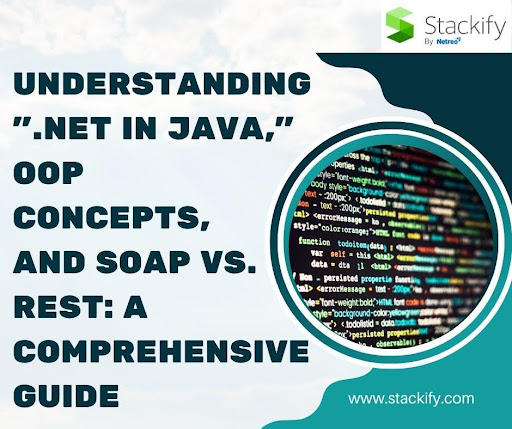
Modern software development requires understanding various technologies, principles, and paradigms to build efficient, scalable, and maintainable applications. This blog explores the use of “.Net in Java,” dives into key OOP (Object-Oriented Programming) concepts, and examines the differences between SOAP and REST in web services. Each section is crafted with developers in mind, ensuring you grasp the essentials while targeting common questions and challenges.
What Is “.Net in Java”?
The mention of “.Net in Java” often refers to interoperability between .NET-based and Java-based technologies. While .NET is a framework primarily for Windows environments, Java is a platform-independent language that runs on any device supporting the Java Virtual Machine (JVM).
Achieving Interoperability
Despite their differences, .NET and Java applications can work together using several approaches:
- Bridging Tools: Libraries like IKVM.NET allow Java code to run on the .NET platform. Conversely, frameworks like Jni4Net enable .NET applications to access Java code.
- Web Services: Developers often use web services like REST or SOAP (discussed later) to facilitate communication between .NET and Java applications.
- Message Queues: Middleware solutions like RabbitMQ or Kafka help establish seamless communication across platforms.
Use Cases
- Hybrid Architectures: Enterprises using both .NET and Java technologies often seek interoperability for system integration.
- Code Portability: Tools like IKVM.NET are particularly useful for reusing Java libraries in .NET applications.
Exploring the Core OOP Concepts
Object-Oriented Programming (OOP) is fundamental for developers working in languages like Java and .NET. OOP focuses on objects and their interactions, promoting code modularity, reusability, and maintainability. Here are the four primary pillars of OOP:
1. Encapsulation
Encapsulation is the practice of bundling data (attributes) and methods (functions) that operate on the data within a single unit—the object. This principle also hides the internal state of objects, exposing only necessary functionalities.
- In Java: Encapsulation is achieved using access modifiers like private, protected, and public.
Example:
public class Car {
private String model;
public String getModel() {
return model;
}
public void setModel(String model) {
this.model = model;
}
}
In .NET (C#):
public class Car {
private string Model;
public string GetModel() => Model;
public void SetModel(string model) => Model = model;
}
2. Inheritance
Inheritance allows one class to inherit the properties and behavior of another, promoting code reusability.
Java Syntax: Use the extends keyword.
class Vehicle {
void move() {
System.out.println(“Moving…”);
}
}
class Car extends Vehicle {
void drive() {
System.out.println(“Driving…”);
}
}
.NET Syntax: Use the : operator in C#.
class Vehicle {
public void Move() {
Console.WriteLine(“Moving…”);
}
}
class Car : Vehicle {
public void Drive() {
Console.WriteLine(“Driving…”);
}
}
3. Polymorphism
Polymorphism enables a single interface to represent different types. It can be achieved through method overloading or method overriding.
Example in Java:
class Animal {
void sound() {
System.out.println(“Animal makes a sound”);
}
}
class Dog extends Animal {
@Override
void sound() {
System.out.println(“Dog barks”);
}
}
In .NET:
class Animal {
public virtual void Sound() {
Console.WriteLine(“Animal makes a sound”);
}
}
class Dog : Animal {
public override void Sound() {
Console.WriteLine(“Dog barks”);
}
}
4. Abstraction
Abstraction hides the complex implementation details and exposes only essential functionalities.
- Using Interfaces or Abstract Classes:
Java:
interface Animal {
void sound();
}
class Dog implements Animal {
public void sound() {
System.out.println(“Dog barks”);
}
}
.NET (C#):
interface IAnimal {
void Sound();
}
class Dog : IAnimal {
public void Sound() {
Console.WriteLine(“Dog barks”);
}
}
SOAP vs. REST
Web services enable communication between applications, and SOAP (Simple Object Access Protocol) and REST (Representational State Transfer) are two primary architectures.
What Is SOAP?
SOAP is a protocol that uses XML for communication. It is strict in standards and often employed in enterprise-grade systems requiring security, transaction control, and reliability.
Key Features:
- Protocol-Driven: Follows a predefined structure for requests and responses.
- Stateful: SOAP supports session management.
- Security: Supports WS-Security for encryption and authentication.
Example SOAP Request:
<soap:Envelope xmlns:soap=”http://schemas.xmlsoap.org/soap/envelope/”>
<soap:Body>
<GetWeather xmlns=”http://example.com/weather”>
<City>Seattle</City>
</GetWeather>
</soap:Body>
</soap:Envelope>
What Is REST?
REST is an architectural style that uses standard HTTP methods (GET, POST, PUT, DELETE). It is lightweight, making it ideal for public APIs and cloud-based services.
Key Features:
- Stateless: Each request is independent.
- Format Flexibility: Supports JSON, XML, or plain text.
- Scalability: REST APIs are lightweight and easier to cache.
Example REST Request:
GET /weather?city=Seattle HTTP/1.1
Host: example.com
Accept: application/json
SOAP vs. REST: A Comparison
| Feature | SOAP | REST |
| Communication | Protocol-based | Architecture-based |
| Data Format | XML only | JSON, XML, or others |
| Ease of Use | Complex | Simple |
| Performance | Slower due to XML overhead | Faster, lightweight |
| Security | Built-in WS-Security | Relies on HTTPS |
Conclusion
Understanding “.Net in Java,” OOP concepts, and the comparison of SOAP and REST is essential for any modern developer. Whether you are bridging platforms, structuring applications with OOP principles, or designing robust web services, these technologies and principles form the backbone of software development.





